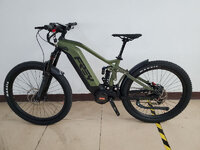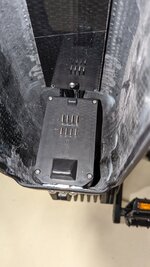3. Speed could not reach anywhere close to 28 mph on level ride with PAS 5. I was in ECO mode. Will test other modes.
Presuming that your controller is set to derive it's limits from the Display unit, your Display's "Max Speed" setting, adjusts what speed at which motor assistance drops out. By default, that may be set lower than the legal limits where you ride. (If the Max Speed setting is unavailable, setting a smaller wheel size enables higher real speeds, but the MPH indicator will be inaccurate.)
The primary limiting factor on top speed for our Frey AM1000 v5, is most certainly the rear end's gear ratios:
We're on a 40-tooth front chainring, pulling a 42-tooth-to-11-tooth rear cassette (with SRAM Eagle NX derailleur). That's below 1:1 ratio for first gear, not quite 4:1 for last gear.
A taller chainring would enable proportionally higher actual top speeds (say, a 44-tooth chainring, or 46, 48, or even 51; all will fit the AM1000).
With all this power on tap,
none of us here in Denver, have been using all the gears on that cassette: 1st is useful
only for climbing extreme slopes ('granny gear'); 3rd is good for gentle takeoffs on flat ground; 5th, 7th, 9th, & 11th all get plenty of use... but none of us are
ever using all the gears in between.
A wider ratio cassette would be very welcome. With so much power, there is no need for close gear spacing.
I am certain that a 44-tooth chainring, with a 46-tooth-to-11-tooth "ultra wide ratio" cassette (over 400% shift range), would result in:
1) Higher actual top speed; currently limited by impractically high pedal cadence, preventing pedal effort from assisting the motor at speeds over ~25 MPH.
2) Longer range at high speeds, from a reduction in cadence allowing pedal effort to contribute far more force (right now, pedal effort contributes roughly nothing, at the flailingly high cadence reached by 28 MPH).
3) Less unnecessary shifting, by virtue of wider gear spacing of "ultra wide ratio" cassettes. Currently, we've been shifting two gears at a time, skipping in-between speeds; mostly using 3rd & 11th a lot.
4) Reduced tooth wear on the chainline, thanks to taller gears overall, & reduced usage of last gear (11-tooth).
Smaller chainrings than 40-tooth
might make sense, for extreme hill climbers who will never need to pedal up to higher speeds; but for all other conditions, the m620 motor at 48V has so much power that there's no benefit to so many shift-points in between, & top speed is reached almost immediately because the pedal cadence gets too high to keep up with meaningfully.
I suspect this is even more pronounced on the higher powered 60V Beast. If you get the chance to try other ratio cassettes & chainrings, please report your findings!
(Also note that re-tuning the pedal torque response is
critical, when changing the end gear ratios & shift points!)




